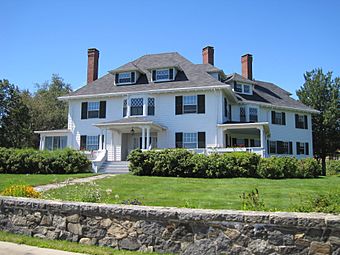Little Boar's Head Historic District facts for kids
Quick facts for kids |
|
|
Little Boar's Head Historic District
|
|

The Bell-Sullivan House
|
|
| Location | Parts of Atlantic Ave., Chapel Rd., Ocean Blvd., Sea Rd., and Willow Ave., North Hampton, New Hampshire |
|---|---|
| Area | 150 acres (61 ha) |
| Architect | Shepley, Rutan & Coolidge; et.al. |
| Architectural style | Colonial Revival, Shingle Style |
| NRHP reference No. | 99000668 |
| Added to NRHP | June 3, 1999 |
The Little Boar's Head Historic District is a special area in North Hampton, New Hampshire. It's a beautiful stretch of coastline with many old summer homes and beach properties. This district is located along New Hampshire's seacoast, between North Hampton State Beach and Bass Beach. Most of the buildings here are houses built as vacation spots in the late 1800s and early 1900s. There are also some cool beach buildings. This historic area was added to the National Register of Historic Places in 1999 because it's so important.
Exploring Little Boar's Head History
Little Boar's Head is a natural hill called a drumlin that was formed by glaciers long ago. It sits right on the New Hampshire coast, looking out over the Gulf of Maine. The historic district follows Ocean Boulevard (New Hampshire Route 1A), which runs along the beach. It also includes properties on Sea Avenue, Atlantic Avenue, Willow Avenue, and Chapel Road. The district starts near North Hampton State Beach and goes north towards Bass Beach. You can find some very old houses here, along with bathhouses by the beach and even some historic fish houses.
How Little Boar's Head Became a Summer Spot
For a long time, Little Boar's Head was a quiet place where people mostly fished and farmed. But things started to change in the mid-1800s. In 1845, a New Hampshire Senator named James Bell bought some land by the coast. Then, in 1862, he built Bell's Cottage for his daughter to use as a summer house. This house, now much bigger, is at 4 Atlantic Avenue. It was one of the very first summer homes built in the area.
Later, in the 1860s, former President Franklin Pierce also bought land here. In 1868, Bachelder's Hotel opened, which became a very popular place for summer visitors. It was a big part of the summer scene until it burned down in 1929. More and more summer houses were built into the early 1900s. Many famous people visited Little Boar's Head, including Presidents Chester A. Arthur, William Howard Taft, and Franklin Delano Roosevelt.
Fuller Gardens: A Beautiful Public Garden
Massachusetts Governor Alvan T. Fuller also had a large estate in Little Boar's Head. His house is no longer there, but he created the amazing Fuller Gardens. This beautiful garden is now open to the public and is managed by a special group that works to keep it beautiful for everyone to enjoy.




